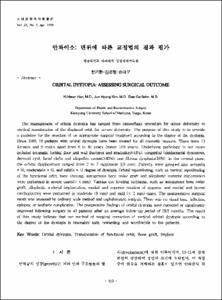KUMEL Repository
1. Journal Papers (연구논문)
1. School of Medicine (의과대학)
Dept. of Plastic Surgery (성형외과학)
안와이소: 변위에 따른 교정법의 결과 평가
- Alternative Author(s)
- Han, Ki Hwan; Kim, Jun Hyung; Son, Dae Gu
- Journal Title
- 대한성형외과학회지
- ISSN
- 1015-6402
- Issued Date
- 1998
- Abstract
- The management of orbital dystopia has ranged from camouflage procedure for minor deformity to vertical translocation of the displaced orbit for severe deformity. The purpose of this study is to provide a guideline for the selection of an appropriate surgical treatment according to the degree of the dystopia. Since 1989, 18 patients with orbital dystopia have been treated for all cosmetic reasons. There were 13 females and 5 males aged from 8 to 46 years (mean 18.8 years). Underlying pathology in our cases included traumatic (orbital floor and wall fractures and irradiation)(44%); congenital (cleidocranial dysostosis, dermoid cyst, facial clefts and idiopathic causes)(40%); and fibrous dysplasia(16%). In the coronal plane, thr orbital displacement ranged from 2 to 7 mm(mean 3.9 mm). Patients were grouped into severe(n=8), moderate(n=6), and mild(n=4) degree of dystopia. Orbital repositioning, such as vertical repositioning of the functional orbit, bone shaving, autogenous bone graft and alloplastic material implantation were performed in severe cases(>4 mm). Various eye leveling technique, such as autogenous bone onlay graft, alloplastic material implantation, medial and superior rotation of zygoma, and medial and lateral canthoplasties were performed in moderate (3 mm) and mild (< 2 mm) cases. The postoperative surgical result was assessed by ordinary scale method cephalometric analysis. There was no visual loss, infection, epilepsy, or asethetic complication. The preoperative findings of orbital dystopia were corrected or significantly improved following surgery in all patients after an average follow-up period of 59.2 months. The result of this study indicate that our method of surgical correction of vertical orbital dystopia according to the degree of the dystopia is resonably safe, rewarding and worthwhile to the patients.
안와이소 환자에서 술전에 두개골꼐측법으로 안와골의 변위돈 정도를 정확하게 검사한 다음 이에 따라 서로 다른 방법을 단독 또는 함께 사용하여 교정한 뒤 그 결과를 두개골계측학적 및 임상적으로 평가해 보았을 때 모든 증례에서 시력장애나 이환율 등의 합병증 없이 잘 교정되어 좋은 결과를 얻을 수 있었다. 그러므로 안와이소를 교정할 때는 안와골의 이소된 정도에 따라 적절한 교정법 즉 안와골의 전체 위치가 서로 다른 중증의 안와이소는 기능적 안와골전위술을, 중등도 미만의 안와골의 부분적인 변위일 때는 관골전위술, 골이식술 및 이물성형물 삽입술이나 연조직 교정술 등을 선택하는 것이 적절할 것으로 생각된다.
- Alternative Title
- ORBITAL DYSTOPIA: ASSESSING SURGICAL OUTCOME
- Department
- Dept. of Plastic Surgery (성형외과학)
- Publisher
- School of Medicine
- Citation
- 한기환 et al. (1998). 안와이소: 변위에 따른 교정법의 결과 평가. 대한성형외과학회지, 25(3), 419–429.
- Type
- Article
- ISSN
- 1015-6402
- Appears in Collections:
- 1. School of Medicine (의과대학) > Dept. of Plastic Surgery (성형외과학)
- 파일 목록
-
-
Download
 oak-bbb-1829.pdf
기타 데이터 / 848.88 kB / Adobe PDF
oak-bbb-1829.pdf
기타 데이터 / 848.88 kB / Adobe PDF
-
Items in Repository are protected by copyright, with all rights reserved, unless otherwise indicated.